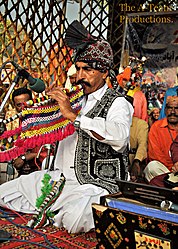
Back আলগোজা Bengali/Bangla Alghoza German Alghoza French જોડિયા પાવા Gujarati अलघोज़ा Hindi അൽഗോസ Malayalam ਅਲਗੋਜ਼ੇ Punjabi الغوزا PNB الغوزو Sindhi Alghoza SIMPLE
 | |
| Woodwind | |
|---|---|
| Other names | Alghoze, Jōrhi, Pāwā Jōrhī, Do Nālī, Donāl, Girāw, Satārā or Nagōze[1] |
| Classification | Woodwind instrument |
| Hornbostel–Sachs classification | 421.112 |
| Developed | around 7500 BC in Mesopotamia[2] |
Alghoza also called Beenon (Sindhi: الغوزو) is a paired woodwind traditional musical instrument of Sindhi culture,[3][4] also used by Kutchi, Saraiki, Punjabi, Rajasthani and baloch folk musicians.[2][1] It consists of two joined beak flutes, one for melody, the second for drone. The flutes are either tied together or may be held together loosely with the hands. A continuous flow of air is necessary as the player blows into the two flutes simultaneously.[5] The quick recapturing of breath on each beat creates a bouncing, swinging rhythm. The wooden instrument initially comprised two flute pipes of the same length but over time, one of them was shortened for sound purposes. In the world of Alghoza playing, the two flute pipes are a couple — the longer one is the male and the shorter one the female instrument. With the use of beeswax, the instrument can be scaled to any tune.[6]

- ^ a b "Alghoza". Asian Music Circuit. Archived from the original on 27 February 2017. Retrieved 7 December 2015.
- ^ a b Chandio, Faraz (September 2, 2018). "CULTURE: THE DYING BREATHS OF THE ALGHOZA". DAWN. Islamabad. Retrieved June 3, 2021.
- ^ "Rich culture: Lok Mela showcases colours of Sindh". The Express Tribune. 2015-04-06. Retrieved 2024-01-23.
- ^ "Interactive sessions: Sukkur IBA concludes conference with culture night". The Express Tribune. 2016-12-17. Retrieved 2024-01-23.
- ^ Pande, p. 70
- ^ Usman, Maryam (2013-08-26). "Instrumental Ecstasy concert: A retreat into the rhythms of Sindhi classical tunes". The Express Tribune. Retrieved 2015-12-07.
© MMXXIII Rich X Search. We shall prevail. All rights reserved. Rich X Search